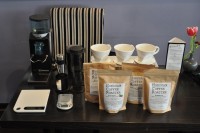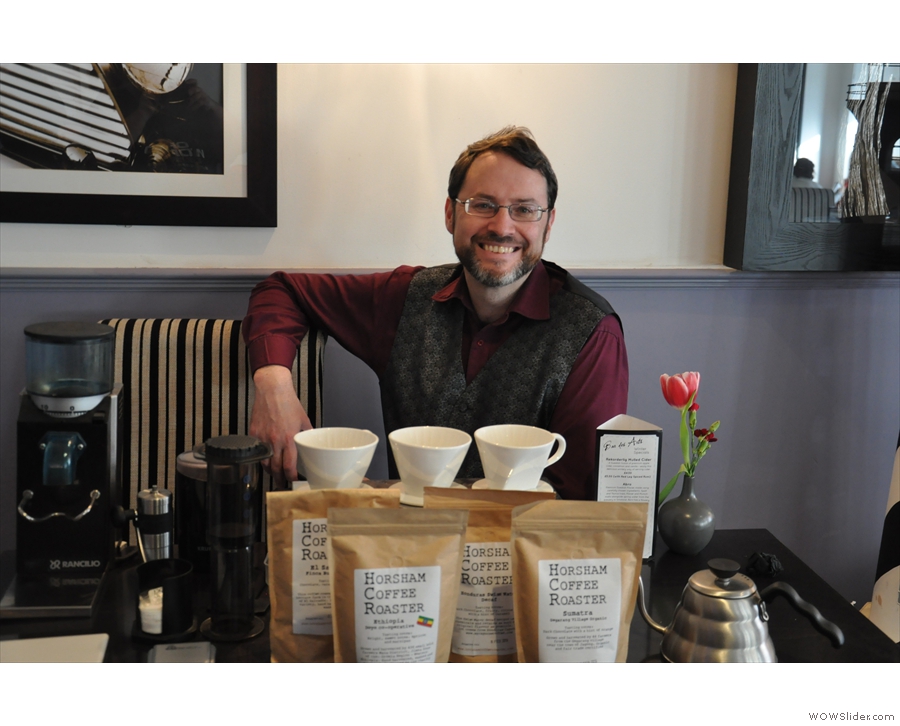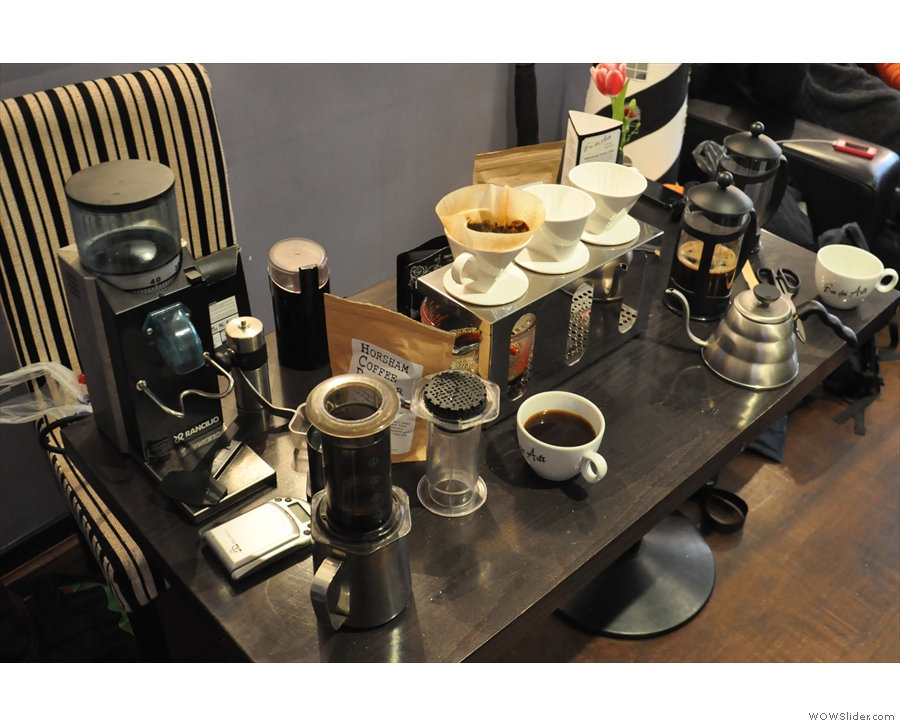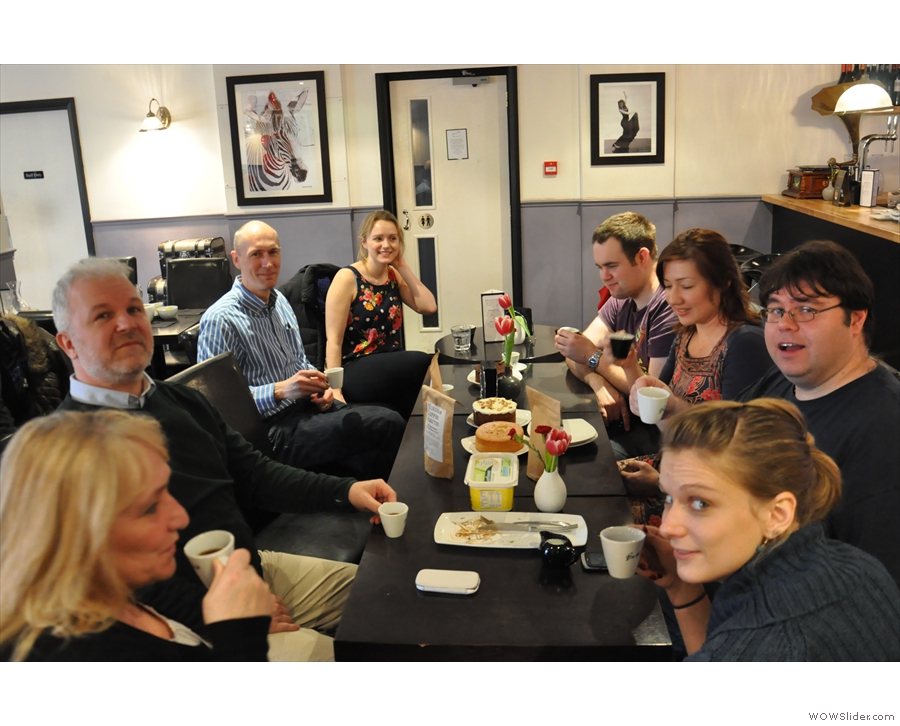 I celebrated my birthday last weekend by inviting a group of friends down to the closest thing I have to a local, Guildford’s Bar des Arts, for a coffee tasting. I’d originally been given the idea by Lee Hall of Matthew Algie when he did a similar demo at the Caffé Culture Show. There he put two different coffees through a pour-over filter and a Chemex and I was astounded by how different they tasted.
I celebrated my birthday last weekend by inviting a group of friends down to the closest thing I have to a local, Guildford’s Bar des Arts, for a coffee tasting. I’d originally been given the idea by Lee Hall of Matthew Algie when he did a similar demo at the Caffé Culture Show. There he put two different coffees through a pour-over filter and a Chemex and I was astounded by how different they tasted.
So, when thinking about how I wanted to celebrate my birthday, I could think of nothing better than surrounding myself with some friends and replicating this experiment. I approached Bradley of Horsham Coffee Roaster, who supplies Bar des Arts, and he provided three very different coffees for us to try. Meanwhile, I brought along my trusty Aeropress (and one of the guests, Richard, brought his down) to go with Bar des Arts pour-over filters and cafetiere.
So, the scene was set for an afternoon of good company, coffee tasting and cake (although, very disappointingly, I seem to have taken exactly no pictures of the cake!).
You can see how we got on after the gallery.
Bradley from Horsham Coffee Roaster had a brief to provide a wide range of tastes/flavours in the coffee he supplied. To this end there was one Central American (El Salvador), one African (Ethiopia) and one Far Eastern (Sumatra) coffee, plus a decaf from Honduras. We were focusing mainly on the three caffeinated coffees and the differences between them, plus the impact of the various preparation methods. The coffees were (click on the link for more details):
- El Salvador Buenos Aires (washed)
- Ethiopia Doyo (washed)
- Sumatra Gegarang village (semi-washed)
After a brief discussion, and a very sensible suggestion from my friend Julian, we decided to start with the most subtle coffee and work our way to the strongest/boldest so that our palettes would hopefully not be overwhelmed at the start!
To this end, the first coffee on the block was the Ethiopian Doyo, described on the packet as having bright, sweet notes of apricot and marzipan. In line with Julian’s suggestion, John (from Bar des Arts) and I put the Ethiopian through the AeroPress, then pour-over filter and, finally, cafetiere. For the uninitiated, the theory is that the Aeropress is best at highlighting subtle notes in coffee, taking out a lot of the bitterness and body, while the cafetiere is at the other end of the scale, leaving a lot of the body and bitterness in, masking the more delicate flavours. The pour-over sits somewhere between the two.
So, in theory, the Aeropress should have best suited the subtle, sweet notes of the Ethiopian and, generally speaking, that was the consensus. While my friends are by-and-large not seasoned third-wave coffee drinkers, they immediately noticed the difference between the three methods, so much so that several of them questioned whether we’d moved onto a different coffee!
In fairness, this was exactly the reaction I had when Lee first did it to me at Caffe Culture and if you’ve never tried drinking the same coffee using different preparation methods, I recommend you try (bizarrely, having owned an Aeropress, two types of pour-over filter and multiple cafetieres, I’d never tried before Lee put the idea in my head!).
We followed the Ethiopian with the El Salvador (chocolate, caramel, cherry and lemon according to the packet) and finished things off with the Sumatran (dark chocolate with a hint of orange). For each method we were only giving people about 20ml (basically half an espresso cup) to keep the caffeine levels down and, between the different coffees, we took a break and ate cake.
So, what did we make of it all?
While people’s tastes varied and the results of the tasting were by no means unanimous, I think it’s fair to say that there was a consensus. Generally speaking (and boringly to type), people preferred the Ethiopian through the Aeropress, El Salvador through the pour-over filter and Sumatran through the cafetiere. Overall, across the three different types of coffee, the clear winner was the El Salvador. Bradley had provided me with various bags to sell and I could have sold out of the El Salvador twice over, while I had a few of the Ethiopian and Sumatran left at the end of the day.
Several people found the Ethiopian too challenging, which didn’t surprise me since that was my experience the first time I tried something like it! The general consensus was that the Sumatran was the most “coffee-like”. For what it’s worth, I’m currently drinking the Sumatran through the cafetiere in the morning and the Ethiopian through the Aeropress in the afternoon. Finally, while we didn’t go into the decaf in as much detail, we sat around drinking it at the end while we polished off the cake and it went down very well.










 1
1 2
2 3
3 4
4 5
5 6
6 7
7 8
8 9
9
Pingback: London Coffee Festival 2014: The Kit | Brian's Coffee Spot
Pingback: 2014 Awards – Best Filter Coffee | Brian's Coffee Spot
Pingback: Small Batch Cupping at Finisterre | Brian's Coffee Spot
Pingback: London Coffee Festival 2015: Coffee Experiences | Brian's Coffee Spot